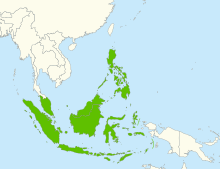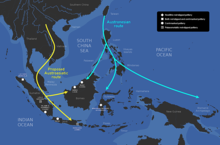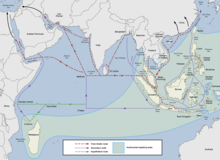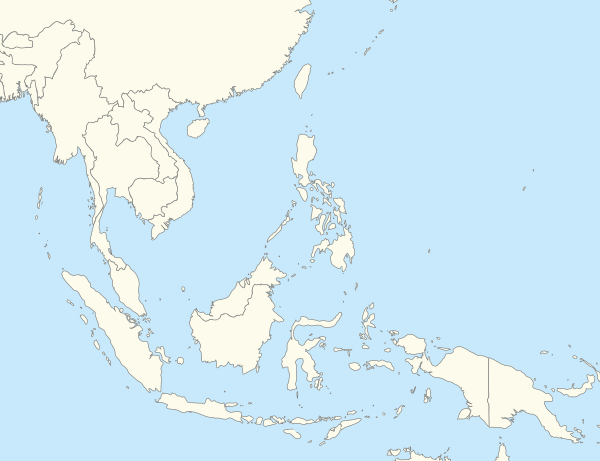This is an old revision of this page, as edited by ThoughtIdRetired (talk | contribs) at 14:14, 23 July 2023 (→Ancient Indian Ocean trade: see Pre-Austronesian dispersal of banana cultivars West from New Guinea: linguistic relics from Eastern Indonesia https://www.jstor.org/stable/40387436 There is good evidence that spread of the banana is unrelated to the Austronesian dispersal. A confident statement in the article that it was is clearly unjustified.). The present address (URL) is a permanent link to this revision, which may differ significantly from the current revision.
Revision as of 14:14, 23 July 2023 by ThoughtIdRetired (talk | contribs) (→Ancient Indian Ocean trade: see Pre-Austronesian dispersal of banana cultivars West from New Guinea: linguistic relics from Eastern Indonesia https://www.jstor.org/stable/40387436 There is good evidence that spread of the banana is unrelated to the Austronesian dispersal. A confident statement in the article that it was is clearly unjustified.)(diff) ← Previous revision | Latest revision (diff) | Newer revision → (diff) Cultural and economic area within Southeast Asia Not to be confused with Malay Archipelago.| Geography | |
|---|---|
| Location | Indonesian Archipelago Philippine Archipelago Peninsular Malaysia East Malaysia Singapore |
| Total islands | 25,000 |
| Major islands | Borneo, Java, Luzon, Mindanao, New Guinea, Sulawesi, Sumatra |
| Area | 2,870,000 km (1,110,000 sq mi) |
| Highest elevation | 4,884 m (16024 ft) |
| Highest point | Puncak Jaya |
| Largest settlement | Bandar Seri Begawan |
| Largest settlement | Jakarta |
| Largest settlement | Kuala Lumpur |
| Largest settlement | Quezon City |
| Largest settlement | Singapore |
| Largest settlement | Dili |
| Demographics | |
| Population | 380,000,000 |
| Ethnic groups | Predominantly Austronesians, with minorities of Negritos, Papuans, Melanesians, descendants of Chinese, Peranakans, Arabs descendants, Eurasians, Mestizos, Asli people, and descendants of Overseas Indians and Sri Lankans |

Maritime Southeast Asia comprises the countries of Brunei, Indonesia, Malaysia, the Philippines, Singapore, and East Timor.
The term Island Southeast Asia, Insular Southeast Asia or rarely referred to by geographers as Northwest Oceania is sometimes given the same meaning as Maritime Southeast Asia. Other definitions restrict Island Southeast Asia to just the islands between mainland Southeast Asia and the continental shelf of Australia and New Guinea. There is some variability as to whether Taiwan is included in this. Peter Bellwood includes Taiwan in his definition, as does Robert Blust, whilst there are examples that do not.
The 16th-century term "East Indies" and the later 19th-century term "Malay Archipelago" are also used to refer to Maritime Southeast Asia.
In Indonesia, the Old Javanese term "Nusantara" is also used as a synonym for Maritime Southeast Asia. The term, however, is nationalistic and has shifting boundaries. It usually only encompasses Peninsular Malaysia, the Sunda Islands, Maluku, and often Western New Guinea and excludes the Philippines.
Stretching for several thousand kilometres, the area features a very large number of islands and boasts some of the richest marine, flora and fauna biodiversity on Earth.
The main demographic difference that sets Maritime Southeast Asia apart from modern Mainland Southeast Asia is that its population predominantly belongs to Austronesian groups. The region contains some of the world's most highly urbanized areas—the Greater Manila Area, Greater Jakarta, Singapore, and Greater Kuala Lumpur—and yet a majority of islands in this vast region remain uninhabited by humans.
Geography
| This section needs additional citations for verification. Please help improve this article by adding citations to reliable sources in this section. Unsourced material may be challenged and removed. Find sources: "Maritime Southeast Asia" – news · newspapers · books · scholar · JSTOR (February 2022) (Learn how and when to remove this message) |
The land and sea area of Maritime Southeast Asia exceeds 2 million km. These are more than 25,000 islands of the area that comprise many smaller archipelagoes.
The major groupings are:
- Peninsular Malaysia (considered part of Maritime Southeast Asia)
- Singapore, Indonesia, East Timor, East Malaysia and Brunei
- Philippines
The seven largest islands are Borneo, Sumatra, Sulawesi and Java in Indonesia; and Luzon and Mindanao in the Philippines.

In the natural sciences, the region is sometimes known as the Maritime Continent. It also corresponds to the biogeographical region of Malesia (not to be confused with "Malaysia"), with shared tropical flora and fauna.
Geologically, the archipelago is one of the most active volcanic regions in the world, producing many volcanoes, especially in Java, Sumatra, and the Lesser Sunda Islands region, where most volcanoes over 3,000 m (9,800 ft) are situated. Tectonic uplifts also produced large mountains, including the highest in Mount Kinabalu in Sabah, Malaysia, with a height of 4,095.2 m (13,436 ft) and Puncak Jaya on Papua, Indonesia at 4,884 m (16,024 ft). Other high mountains in the archipelago include Puncak Mandala, Indonesia at 4,760 m (15,620 ft) and Puncak Trikora, Indonesia, at 4,750 m (15,580 ft).
The climate throughout the archipelago is tropical, owing to its position on the Equator.
Biogeography
Island Southeast Asia is crossed by the Wallace Line. This line divides the flora and fauna of Asia from that of Australia and New Guinea with stretches of water that have always been too wide for plant and animal species to cross readily. The gaps are considered to be large enough to make accidental rafting from one side to another to be unlikely events. Apart from birds, species that have managed to cross this line include those that have been moved by humans. There is a transitional zone adjacent to the Wallace Line that is termed Wallacea. This is a zone where examples of animal and plant species from both sides can be found, but, particularly on smaller islands, there may be a greatly reduced number of terrestrial species.
The biographical division of the region is important for understanding the spread of both modern and archaic humans into the region. The Wallace Line represents a sea barrier that has persisted, as far as is known, even at the lowest sea levels of glacial maxima of the Pleistocene and the Holocene. Therefore we know when watercraft of some (admittedly unknown) description must have been used for humans to cross the sea.
Culture and demographics
See also: Demographics of Southeast AsiaAs of 2017, there were over 540 million people living in the region, with the most populated island being Java. The people living there are predominantly from Austronesian subgroupings and correspondingly speak western Malayo-Polynesian languages. This region of Southeast Asia shares social and cultural ties with both the peoples of mainland Southeast Asia and with other Austronesian peoples in the Pacific. Islam is the predominant religion, with Christianity being the dominant religion in the Philippines and East Timor. Buddhism, Hinduism, and traditional Animism are also practiced among large populations.
Historically, the region has been referred to as part of Greater India, as seen in Coedes' Indianized States of Southeast Asia, which refers to it as "Island Southeast Asia"; and within Austronesia or Oceania, due to shared ethnolinguistic and historical origins of the latter groups (Micronesian and Polynesian groups) being from this region.
History
See also: History of Southeast Asia
The maritime connectivity within the region has been linked to it becoming a distinct cultural and economic area, when compared to the 'mainland' societies in the rest of Southeast Asia. This region stretches from the Yangtze delta in China down to the Malay Peninsula, including the South China Sea, Gulf of Thailand and Java Sea. The region was dominated by the thalassocratic cultures of the Austronesian peoples.
Ancient Indian Ocean trade

The first true maritime trade network in the Indian Ocean was by the Austronesian peoples of Island Southeast Asia. They established trade routes with Southern India and Sri Lanka as early as 1500 BC, ushering an exchange of material culture (like catamarans, outrigger boats, lashed-lug and sewn-plank boats, and paan) and cultigens (like coconuts, sandalwood, and sugarcane); as well as connecting the material cultures of India and China. Indonesians, in particular were trading in spices (mainly cinnamon and cassia) with East Africa using catamaran and outrigger boats and sailing with the help of the Westerlies in the Indian Ocean. This trade network expanded to reach as far as Africa and the Arabian Peninsula, resulting in the Austronesian colonization of Madagascar by the first half of the first millennium AD. It continued up to historic times.
Maritime Silk Road
Main article: Maritime Silk RoadThe ancient Austronesian trade networks was later used by the first Chinese trading fleets of the Song Dynasty at around 900 AD. It led to a renewed flourishing of trade between China and Southeast Asia, now known as the Maritime Silk Road. Demand for Southeast Asian products and trade was partially driven by the increase in China's population in this era, whereby it doubled from 75 to 150 million.
Trade with China ceased after the collapse of the Song Dynasty due to invasions and famine. It was restored during the Ming Dynasty from the 14th to 16th centuries. The naval expeditions of Zheng He between 1405 and 1431 also played a critical role in opening up of China to increased trade with Southeast Asian polities.
Chinese trade was strictly controlled by the Imperial Court, but the Hokkien diaspora facilitated informal trade and cultural exchange with Southeast Asia, settling among Southeast Asian polities during this time period. Despite not having the official sanction of the Chinese government these communities formed business and trade networks between cities such as Melaka, Hội An and Ayutthaya. Many of these Chinese businesspeople integrated into their new countries, becoming political officials and diplomats.

See also
- Southeast Asia
- Brunei Darussalam–Indonesia–Malaysia–Philippines East ASEAN Growth Area
- Philippine archipelago
- Indonesian archipelago
- Farther India
- Greater India
- Greater Indonesia
- Maritime Continent
- Malay race
- Malay world
- Malesia
- Nanyang
- Peninsular Malaysia
- Domesticated plants and animals of Austronesia
Notes
- For instance Tom Hoogervorst's chapter in The Routledge Handbook of Archeaology and Globalization: "I use Island Southeast Asia and Maritime Southeast Asia interchangeably."
- Bellwood's definition: "Island Southeast Asia includes Taiwan, the Philippines, Brunei and the Sarawak and Sabah provinces of East Malaysia (northern Borneo), and all of the islands of Indonesia to the west of New Guinea."
- Robert Blust: "The major western island groups include the great Indonesian, or Malay Archipelago, to its north the smaller and more compact Philippine Archipelago, and still further north at 22 to 25 degrees north latitude and some 150 kilometres from the coast of China, the island of Taiwan (Formosa). Together these island groups constitute insular (or island) Southeast Asia."
- "Island Southeast Asia (ISEA) comprises the tropical islands lying in between mainland East Asia and Taiwan to the northwest and Australia and New Guinea to the southeast."
References
- Moores, Eldridge M.; Fairbridge, Rhodes Whitmore (1997). Encyclopedia of European and Asian regional geology. Springer. p. 377. ISBN 0-412-74040-0. Retrieved 30 November 2009.
- Department of Economic and Social Affairs Population Division (2006). "World Population Prospects, Table A.2" (PDF). 2006 revision. United Nations. pp. 37–42. Archived from the original (PDF) on 2017-10-31. Retrieved 2007-06-30.
- Tarling, Nicholas (1999). The Cambridge history of Southeast Asia, Volume 1, Part 1 (2nd ed.). Cambridge University Press. p. 304. ISBN 978-0-521-66369-4.; RAND Corporation Archived 2012-10-05 at the Wayback Machine. (PDF); Ciorciar, John David (2010). The Limits of Alignment: Southeast Asia and the Great Powers Since 197. Georgetown Univeffrsity Press. p. 135. ISBN 978-1589016262.; Nichiporuk, Brian; Grammich, Clifford; Rabasa, Angel; DaVanzo, Julie (2006). "Demographics and Security in Maritime Southeast Asia". Georgetown Journal of International Affairs. 7 (1): 83–91. Archived from the original on 2020-08-15. Retrieved 2020-08-11.
- Hoorgervorst, Tom (2017). "8.4". In Hodos, Tamar (ed.). The Routledge handbook of archaeology and globalization. London New York: Routledge. p. 751. ISBN 9781315449005.
- ^ Bellwood, Peter S. (2017). First islanders: prehistory and human migration in Island Southeast Asia (First ed.). Hoboken: Wiley Blackwell. ISBN 9781119251552.
- Bulbeck, David (2014). "Island Southeast Asia: Neolithic". Encyclopedia of Global Archaeology. Springer. pp. 4090–4096. doi:10.1007/978-1-4419-0465-2_866. Retrieved 16 July 2023.
- Evers, Hans-Dieter (2016). "Nusantara: History of a Concept". Journal of the Malaysian Branch of the Royal Asiatic Society. 89 (1): 3–14. doi:10.1353/ras.2016.0004. S2CID 163375995.
- Moores, Eldridge M.; Fairbridge, Rhodes Whitmore (1997). Encyclopedia of European and Asian regional geology. Springer. p. 377. ISBN 0-412-74040-0. Retrieved 30 November 2009.
- Philippines: General Information. Government of the Philippines. Retrieved 2009-11-06; "World Economic Outlook Database" (Press release). International Monetary Fund. April 2006. Retrieved 2006-10-05.; "Indonesia Regions". Indonesia Business Directory. Archived from the original on 2005-12-28. Retrieved 2007-04-24.
- Gaynor, Jennifer L. (2014). "Maritime Southeast Asia, Not Just a Crossroads". Education About Asia. 19 (2): 16. Archived from the original on April 25, 2021. Retrieved April 25, 2021.
- Coedes, G. (1968) The Indianized States of Southeast Asia Edited by Walter F. Vella. Translated by Susan Brown Cowing. Canberra: Australian National University Press. Introduction... The geographic area here called Farther India consists of Indonesia, or island Southeast Asia....
- See the cultural macroregions of the world table below.
- Sutherland, Heather (2003). "Southeast Asian History and the Mediterranean Analogy" (PDF). Journal of Southeast Asian Studies. 34 (1): 1–20. doi:10.1017/S0022463403000018. JSTOR 20072472. S2CID 55467229. Archived (PDF) from the original on 2021-01-17. Retrieved 2019-12-10.
- ^ Manguin, Pierre-Yves (2016). "Austronesian Shipping in the Indian Ocean: From Outrigger Boats to Trading Ships". In Campbell, Gwyn (ed.). Early Exchange between Africa and the Wider Indian Ocean World. Palgrave Macmillan. pp. 51–76. ISBN 9783319338224. Archived from the original on 2023-03-26. Retrieved 2020-11-27.
- Brides of the sea: port cities of Asia from the 16th-20th centuries. Broeze, Frank. Honolulu: University of Hawaii Press. 1989. ISBN 978-0824812669. OCLC 19554419.
{{cite book}}: CS1 maint: others (link) - ^ Mahdi, Waruno (1999). "The Dispersal of Austronesian boat forms in the Indian Ocean". In Blench, Roger; Spriggs, Matthew (eds.). Archaeology and Language III: Artefacts languages, and texts. One World Archaeology. Vol. 34. Routledge. pp. 144–179. ISBN 0415100542.
- Doran, Edwin Jr. (1974). "Outrigger Ages". The Journal of the Polynesian Society. 83 (2): 130–140. Archived from the original on 2019-06-08. Retrieved 2019-07-14.
- Doran, Edwin B. (1981). Wangka: Austronesian Canoe Origins. Texas A&M University Press. ISBN 9780890961070.
- Blench, Roger (2004). "Fruits and arboriculture in the Indo-Pacific region". Bulletin of the Indo-Pacific Prehistory Association. 24 (The Taipei Papers (Volume 2)): 31–50. Archived from the original on 2021-03-08. Retrieved 2019-07-14.
- Lieberman, Victor B. (2003–2009). Strange parallels: Southeast Asia in global context, c 800-1830. New York: Cambridge University Press. ISBN 978-0521800860. OCLC 49820972.
- Sen, Tansen (2006). "The Formation of Chinese Maritime Networks to Southern Asia, 1200-1450". Journal of the Economic and Social History of the Orient. 49 (4): 421–453. doi:10.1163/156852006779048372. JSTOR 25165168.
- Reid, Anthony (1988–1993). Southeast Asia in the age of commerce, 1450-1680. Rogers D. Spotswood Collection. New Haven: Yale University Press. ISBN 978-0300039214. OCLC 16646158.
- YOKKAICHI, Yasuhiro. "Chinese and Muslim Diasporas and Indian Ocean Trade under the Mongol Hegemony". Angela Schottenhammer the East Asian Mediterranean: Maritime Crossroads of Culture, Commerce, and Human Migration. Wiesbaden: Otto Harrassowitz. Archived from the original on 2022-04-11. Retrieved 2018-07-29.
- Lockard, Craig A. (2010-08-01). ""The Sea Common to All": Maritime Frontiers, Port Cities, and Chinese Traders in the Southeast Asian Age of Commerce, ca. 1400–1750". Journal of World History. 21 (2): 219–247. doi:10.1353/jwh.0.0127. ISSN 1527-8050. S2CID 162282960.
- Sojourners and settlers: histories of Southeast Asia and the Chinese. Reid, Anthony, 1939-, Alilunas-Rodgers, Kristine. Honolulu: University of Hawai'i Press. 2001. ISBN 978-0824824464. OCLC 45791365.
{{cite book}}: CS1 maint: others (link)
External links
Portal:- Art of Island Southeast Asia, a full text exhibition catalog from The Metropolitan Museum of Art